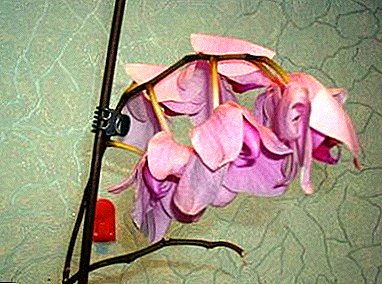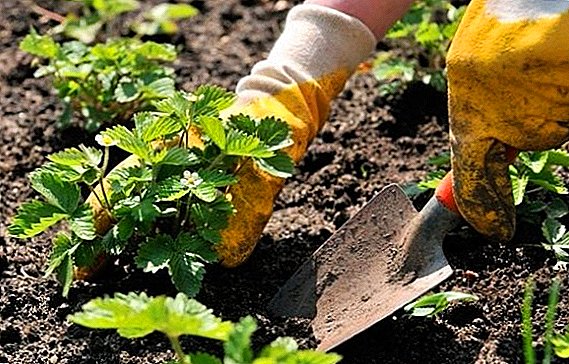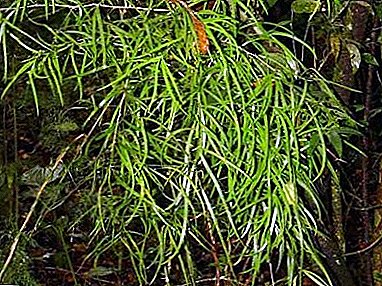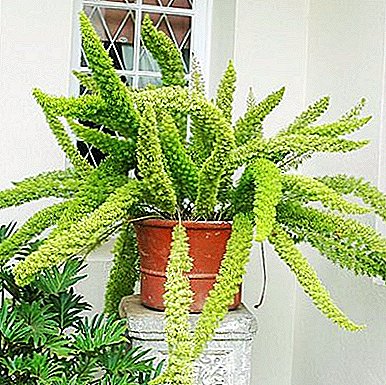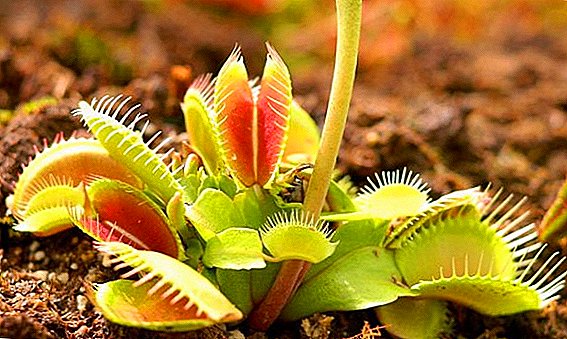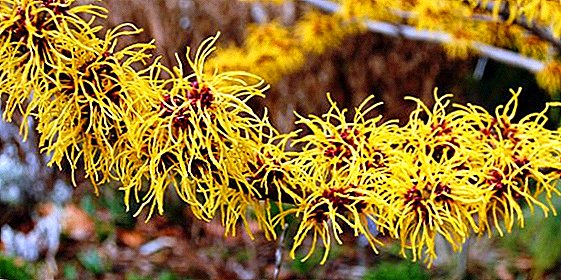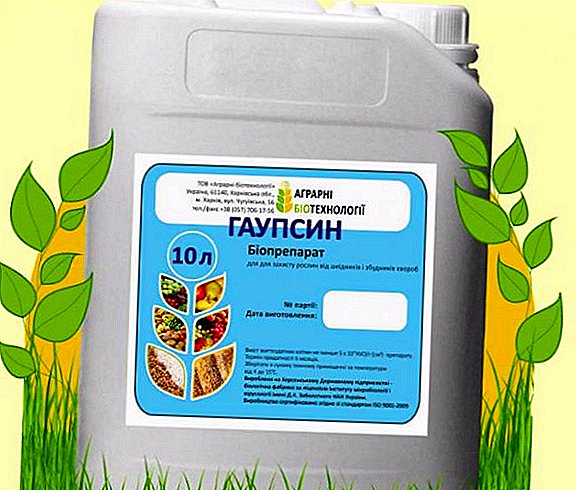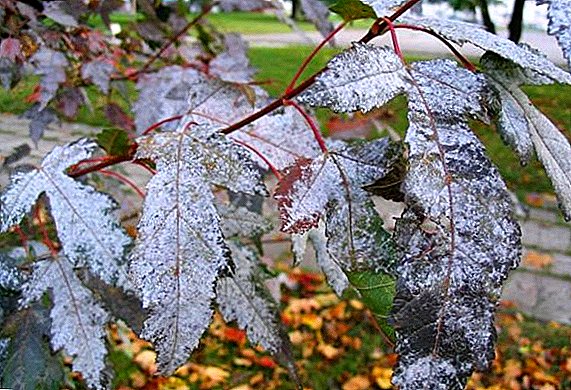 One of the many plant diseases is powdery mildew.
One of the many plant diseases is powdery mildew.
Let's see what kind of disease it is, what kind of harm it is and how to deal with it.
What is the harm?
Mealy dew initially manifests itself as a white bloom on plants that has formed the mycelium fungus. Initially, the raid is like a web. Over time, it becomes similar to the powder. Strikes plaque sheet on both sides.  Most often, young branches and leaves are affected: they contain many nutrients needed by the mycelium. The danger to plantations is that mushrooms spread rapidly throughout the plant.
Most often, young branches and leaves are affected: they contain many nutrients needed by the mycelium. The danger to plantations is that mushrooms spread rapidly throughout the plant.
Then the leaves turn brown, black dots appear on them, twisting and drying, they begin to fall off. The same fate awaits buds and flowers plantations. If the plant is not treated, it will quickly die.
Learn more about how to deal with powdery mildew on cucumbers, on roses, on tomatoes, on apple trees, on currants, on houseplants.
Description and signs of the disease
Mealy dew is a fungal disease caused by powdery mildew fungi, which parasitize on deciduous plants and lead to their death. This disease manifests as white bloom on the leaves of indoor or garden plants.  At first, you can not pay attention to it or even erase it. But over time, the raid appears again, expanding its boundaries and affects the whole planting.
At first, you can not pay attention to it or even erase it. But over time, the raid appears again, expanding its boundaries and affects the whole planting.
Most vulnerable plants
Only deciduous plants are ill with powdery mildew: trees, shrubs and even flowers. Also, this disease causes great damage to ornamental plants such as daisy, chrysanthemum, forget-me-not and many others. The course and development of the disease in all plants is about the same. A disease develops most often in warm cloudy weather and with high humidity.
Important! Powdery mildew develops best at 18-25 ° C and high humidity.
Causes of disease
The reason for the appearance are mushrooms. For each planting it is a mushroom, that is, the mushroom that parasites on oaks will not switch to roses.  Mushrooms appear from the soil. And this happens at a warm temperature and humidity of about 65-80% with constant drying of the soil or with a constant overflow, high levels of nitrogen in the ground or cutting the plant fungus becomes active.
Mushrooms appear from the soil. And this happens at a warm temperature and humidity of about 65-80% with constant drying of the soil or with a constant overflow, high levels of nitrogen in the ground or cutting the plant fungus becomes active.
Getting on the plant, it penetrates into the leaves and begins to feed on the beneficial substances inside the leaf. The mushroom grows and forms a mycelium. Over time, the spores of the mycelium burst, and the seeds of the mushrooms "fly" on neighboring leaves or plants.
How to fight: folk and chemical means
To fight this fungal disease can and should be. It is necessary to remember a few rules that will help not only prevent the appearance of the disease, but also suggest how to get rid of the powdery mildew, if it only appeared:
- water the plant only after the soil dries;
- spray plants can not;
- diseased plants must be brought to light;
- it is also necessary to monitor the fallen leaves: they should not lie on the ground.
 Use nitrogen fertilizer less. It is better to replace them with phosphorus-sodium (during remission). During the period of illness it is not recommended to fertilize the land at all. Let's see what a means of powdery mildew helps for each class of plants.
Use nitrogen fertilizer less. It is better to replace them with phosphorus-sodium (during remission). During the period of illness it is not recommended to fertilize the land at all. Let's see what a means of powdery mildew helps for each class of plants.It will be useful for you to learn about such plant diseases as brown spot, mildew, scab, moniliosis.
On vegetables
- Cucumbers. In case of disease of vegetables, it is necessary to remove the damaged parts of the plant. From folk remedies suitable deposition of sulfur powder in the ratio of 25-30 g per 10 square meters. The colloid sulfur solution also helps: for 35 liters of water, 25-30 g of sulfur. Of the drugs for the treatment of cucumbers fit "Topaz" and "oxy". Before use, read the instructions.

- Tomatoes. The disease appears in two ways: either at the edges the leaves begin to dry out and over time the young plant dies, or yellow spots appear on the upper side of the leaf. In this case, the plaque is visible only on the back side of the leaves of vegetables. Over time, it appears on the upper side of the leaves of the plant. If the tomatoes are sick, they must be sprayed with sodium humate solution. When spraying, read the instructions. Helps with this disease and "Baktofit." It is necessary to process 3 times with an interval of 1-1.5 weeks. Planriz will also help with powdery mildew. Do not forget about the help of drugs such as "Kvadris", "Byleron" and "Strobe." In the solutions of these drugs, it is advisable to add soap.

Did you know? To create 1 ton of tomato paste, you need to grow 5.8 tons of tomatoes.
- Squashes. The land around diseased zucchini must be dug up. It is also necessary to spray this plant with a solution of ash or manure. Of the drugs you need to use "Kefalon", as well as phosphorus sodium.

- Eggplant. You can deal with the disease through a solution of soda ash or with the help of "Fundazol". It is necessary to spray the plant 4-5 times with an interval of 7 days.

On fruits and berries
- Mealy dew on currants noticeable immediately. If you do not fight it from the very beginning, by the beginning of autumn the bush will die. The harm of the disease is also dangerous in that it affects all kinds of currants. If one bush is injured, all the bushes may die. In the fight for currants, it needs to be treated with both chemical and folk remedies to combat powdery mildew. You can treat the shrub with natural methods - ash solution, whey, manure solution, and so on. Among the chemical preparations, Nitrafen will be effective or spraying a solution of copper sulfate. In the summer it is best to spray soda ash. In the spring - copper oxychloride.

- Gooseberry. Gooseberries are treated with kefir, manure, soda, infusion of hay, ash, decoction of horsetail. Will help for the recovery of shrubs and "Gaucin" with "Trichodermin", as well as "Fitosporin".

- Grapes The conditions under which the disease develops best are from 18 to 25 degrees of heat and strong humidity. With low humidity, the disease does not develop. Treat grapes (at +20 ° C and more) with a solution of sulfur in water: 10 g of water per 90 g of sulfur. When the temperature is below 20 ° C, colloidal sulfur is useful for treatment. During fruit ripening it is best to use a weak solution of potassium permanganate. Among the chemical preparations that help eradicate the disease, it is better to use Tiovit Jet, Kvadris or Topaz.

Did you know? To get 1 kg of raisins, you need 4 kg of fresh grapes.
- Apple tree. Mealy dew is dangerous for apple trees and garden trees, which can reduce the protective function of trees to frost, which means that the apple tree can not survive the winter. In addition, this disease reduces the yield of apples by half. To protect the trees, they can be treated with soda ash along with soap and copper chlorine dioxide. Apple trees are treated with “Topaz” with a break of 6-12 days. Before treatment, remove all infected tree branches.

- Strawberry. This disease is manifested on strawberries in the form of plaque on the back of the leaves. With the progression of the disease, it goes to the mustache and berries of the plant. Fruits may smell like mold. Strawberry treatment is carried out with the help of drugs "Kvadris", "Switch" or "Bayleton". After the appearance of the first berries can be processed "Fundazol". Carefully handle strawberry leaves on both sides and do not forget about the instructions for these preparations.
 In addition, in the struggle for a good harvest, you can help "TMTD" or 1% suspension of colloidal sulfur.
In addition, in the struggle for a good harvest, you can help "TMTD" or 1% suspension of colloidal sulfur.On garden flowers
- Phlox also suffer from flour dew, it affects the stems of flowers. First, the color of the plaque is white, but then it changes to brown. Infected leaves must be removed and processed flowers 2-3 times with 1% suspension of colloidal sulfur. Repeat the procedure after 7 days until the flower recovers.

- Roses. If you see roses getting sick, Phytosoprin-M, colloid soda, and also Maxim will help you to cure them. In the spring and autumn, prepare a solution to combat this disease from 50 g of soda ash, 10 liters of water, 300 g of soap (preferably green) and 15 g of copper oxychloride. Treat the roses with this solution and they will be healthy.

- Petunia To cure petunia, it is necessary to remove all the diseased parts of the plant. Next, you need to process the flower "Previkur", "Topaz" or "Fundazol." For potted petunias, after removing the infected parts of the flower, it is necessary to remove the infected layer of earth and replace it with a new one that needs to be treated with Fitosporin-M. A solution of ash, whey, and mustard is also good at fighting with powdery mildew.

- Violets are infected with this disease during heavy irrigation, large amounts of nitrogen fertilizers or in very warm weather. Powdery mildew can be cured with the help of “Morestan”, “Topsina-M”, soda ash and soap, or with the help of “Fundazol”.

On indoor plants
White bloom on indoor plants, which appeared when the temperature drops or the air in the room is rough, this is powdery mildew. This white bloom on indoor flowers is dangerous because, if the plants are located close to each other, a healthy plant can get sick. As a result, due to the powdery mildew, the flower rots and dies.
Important! Most often, powdery mildew suffers from gerbera, kalanchoe, begonia and rose.Potted powder for powdery mildew using potassium permanganate solution or tincture of garlic. Soda ash will also help.
Of the chemical drugs, Hom, Bayleton, Topaz, or Skor will help best. Before using the drug, read its instructions. 
Prevention of appearance
It is known that any disease is easier to prevent than to cure. Let's see what are the methods of prevention of plants from powdery mildew.
- Whey solution. 1 liter of serum to combine with 10 l of water. Next, the solution is applied to the damaged stems at least 3 times with an interval of 3 days.
- Broth from a horsetail. A solution in the ratio of 1:10 (horsetail with water) is boiled for 1.5 hours. Then it is filtered, again diluted with water with the calculation of 1 liter of solution per 5 l of water. Spray the bushes with this solution. Store the solution in a warm place for no more than 7 days.
- Mustard. 1-2 tbsp. l dry mustard diluted with 10 liters of hot water. Cool. Next, the solution or water the earth, or sprayed the plant.
- Copper sulfate. 5 g of copper sulfate is dissolved from 1 tbsp. water. Additionally, 5 g of water (warm) is diluted with 50 g of soap. The solution of vitriol is combined with a soap solution. The plant is sprayed 2-3 times a day with a frequency of 6-7 days.
- Tincture of manure. Infused 1 kg of manure to 3 liters of water. After that, the solution is diluted with 3 liters of water. Used as a means of spraying shrubs.
- Baking soda and soap. Dissolve in 4 liters of water 1 tbsp. spoons of soda and ½ tsp. of soap. Spray 2-3 times a day with an interval of 6-7 days.
- A solution of ash and soap. In 10 liters of warm water add 1 kg of ash. During infusion, the solution is stirred. After that, it is poured into a clean dish and add liquid soap. Used as a spray. 10 liters of water are added to the residue of the ash solution and the shrub is watered.
- Potassium permanganate 5 g of potassium permanganate is diluted with 1 l of water. Spray 2-3 times with an interval of 5 days.
- Soda ash and soap. In 5 liters of hot water, add 5 g of soap and 25 g of soda. Cool. Spray the soil and plant 2-3 times with an interval of 7 days.

I would also like to focus on preventive measures for the treatment of individual, the most common green plants.
- Cucumbers. Prevention is the correct fit and care, as well as spraying the drug "Kvadris".
- Tomatoes. For the prevention of powdery mildew, it is necessary to soak tomato seeds in a solution from Immunocytophyte or Epin 42 days before planting into the ground. You can also treat the tomatoes with 10% whey or a solution of ash.
- Squashes. Powdery mildew prevention on squash: spray with Nitrafen in spring. Folk methods are sprayed every other day in dry weather.
- Grapes Use a solution of sulfur - 25-40 g per 10 liters of water.
- Apple tree. To prevent this serious disease, wood should be treated with Topaz.
- Strawberry. Do not plant strawberries too thick. Weed it in time and transplant those bushes that are too close to the "relatives".
- Phlox. Mulching with humus or peat. In the spring, phloxes are treated three times with 1% Bordeaux liquid. Repeat the procedure after 12-14 days. It is also necessary to fertilize flowers with mineral fertilizers.
- Roses. In time, weed the weeds. In the autumn, it is advised to gather and burn the vegetation in the garden, and dig the soil.
- Houseplants need potash and phosphate fertilizers to control powdery mildew, airing the room, proper watering and general flower hygiene.
 Thus, it is possible and necessary to deal with powdery mildew. The main thing - do not run your pets and always remain only in the win from a good harvest.
Thus, it is possible and necessary to deal with powdery mildew. The main thing - do not run your pets and always remain only in the win from a good harvest.

